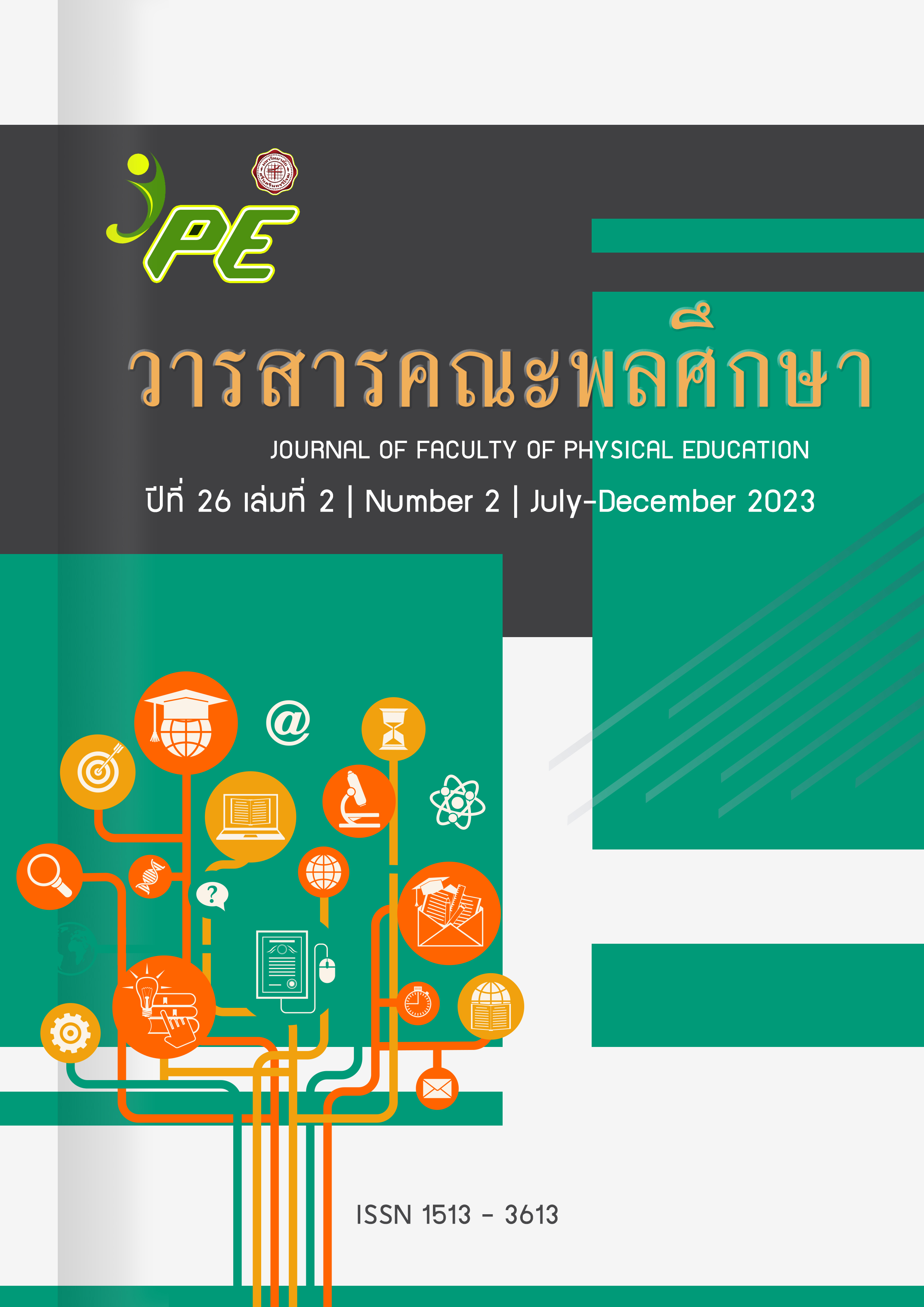การศึกษาและเปรียบเทียบผลการฝึกการออกตัว 3 รูปแบบที่มีต่อความเร็วและการเร่งความเร็วระยะทาง 30 เมตร ของนักวิ่งระยะสั้นระดับมหาวิทยาลัย
Main Article Content
บทคัดย่อ
การวิจัยนี้ทำการศึกษา เพื่อทราบถึงความแตกต่างของความเร็ว การเร่งความเร็ว ความยาวก้าว และจำนวนก้าว ในการออกตัววิ่ง ด้วยท่าบล็อกสตาร์ท ท่า 2 จุด และท่า 3 จุด สำหรับใช้เป็นแนวทางในการฝึกซ้อมนักกีฬาเพื่อพัฒนาศักยภาพ กลุ่มตัวอย่างจำนวน 16 คน โดยสุ่มแบบเฉพาะเจาะจง (Purposive Random sampling) งานวิจัยนี้ใช้ MICROGATE รุ่น OPTOJUMP NEXT ITALY วัดการเร่งความเร็ว ความยาวก้าว และจำนวนการก้าวและยี่ห้อ MICROGATE รุ่น WITTY WIRELESS TRAINING TIMER วัดเวลา Two-way MANOVA with repeated measures เพื่อวิเคราะห์ความแตกต่างของเวลา จำนวนการก้าว และความยาวก้าว ระหว่างการเริ่มต้นออกวิ่ง 3 รูปแบบ ผลการวิจัยพบว่า การออกตัวด้วยบล็อกสตาร์ท (Block Start) ก่อนการฝึก การออกตัวด้วยบล็อกสตาร์ทและท่า 2 จุด มีความแตกต่างกันของความเร็วระยะ 5, 10, 30 เมตร ไม่พบความแตกต่างกันของการเร่งความเร็ว ความยาวก้าว และจำนวนก้าว ระหว่างการออกตัวแต่ละแบบ หลังการฝึก การออกตัวด้วยบล็อกสตาร์ทและท่า 2 จุด ยังคงมีความเร็วแตกต่างกันทั้ง 3 ระยะ อย่างมีนัยสำคัญทางสถิติที่ระดับ .05 ไม่พบความแตกต่างกันของการเร่งความเร็ว ความยาวก้าว และจำนวนก้าว ระหว่างการออกตัวแต่ละแบบ นอกจากนี้ไม่พบความแตกต่างของการออกตัวด้วยท่า 3 จุด กับท่า 2 จุด ของความเร็ว การเร่งความเร็ว ความยาวก้าว และจำนวนก้าว รวมถึงบล็อกสตาร์ทกับท่า 3 จุด ทั้ง 3 ระยะทาง ผลลัพธ์ดังกล่าวอาจมีปริมาณการฝึกซ้อมที่มีระยะเวลาการฝึกสั้น ส่งผลให้นักกีฬายังไม่เกิดการกระตุ้นของร่างกาย ทำให้การพัฒนานักกีฬาไม่มีประสิทธิภาพและไม่บรรลุเป้าหมายของการฝึกซ้อม
Article Details

This work is licensed under a Creative Commons Attribution-NonCommercial-NoDerivatives 4.0 International License.
บทความและข้อคิดเห็นใดๆ ในวารสาร เป็นทัศนะของผู้เขียน คณะพลศึกษาไม่จำเป็นต้องเห็นชอบด้วยเสมอไปผู้ใดประสงค์จะนำข้อความไปตีพิมพ์หรือเผยแพร่ต้องได้รับอนุญาตจากผู้เขียนโดยตรง
References
Bonnechere, B., Beyer, B., Rooze, M., & Sint, J. S. (2014). What is the Safest Sprint Starting Position for
American Football Players? J Sports Sci Med, 13(2), 423-429.
Hamner, S. R., & Delp, S. L. (2013). Muscle contributions to fore-aft and vertical body mass center accelerations
over a range of running speeds. J Biomech, 46(4), 780-787. https://doi.org/10.1016/j.jbiomech.2012.11.024
Haugen, T. A., Tønnessen, E., & Seiler, S. K. (2012). The difference is in the start: impact of timing and start
procedure on sprint running performance. J Strength Cond Res, 26(2), 473-479. https://doi.org/10.1519/JSC.0b013e318226030b
Macadam, P., Nuell, S., Cronin, J. B., Nagahara, R., Uthoff, A. M., Graham, S. P., Tinwala, F., & Neville, J.
(2019). Kinematic and kinetic differences in block and split-stance standing starts during 30 m sprint-running. Eur J Sport Sci, 19(8), 1024-1031. https://doi.org/10.1080/17461391.2019.1575475
Macadam, P., Mishra, M., Feser, E. H., Uthoff, A. M., Cronin, J. B., Zois, J., Nagahara, R., & Tinwala, F. (2020).
Force-velocity profile changes with forearm wearable resistance during standing start sprinting. Eur J Sport Sci, 20(7), 915-919. https://doi.org/10.1080/17461391.2019.1686070
Martínez-Valencia, M. A., Romero-Arenas, S., Elvira, J. L., González-Ravé, J. M., Navarro-Valdivielso, F., &
Alcaraz, P. E. (2015). Effects of Sled Towing on Peak Force, the Rate of Force Development and Sprint
Performance During the Acceleration Phase. J Hum Kinet, 46, 139-148.
https://doi.org/10.1515/hukin-2015-0042
Maulder, P. S., Bradshaw, E. J., & Keogh, J. W. (2008). Kinematic alterations due to different loading schemes in
early acceleration sprint performance from starting blocks. J Strength Cond Res, 22(6), 1992-2002. https://doi.org/10.1519/JSC.0b013e31818746fe
Otsuka, M., Kurihara, T., & Isaka, T. (2015). Effect of a Wide Stance on Block Start Performance in Sprint
Running. PLoS One, 10(11), e0142230. https://doi.org/10.1371/journal.pone.0142230
Otsuka, M., Kurihara, T., & Isaka, T. (2017). Timing of Gun Fire Influences Sprinters' Multiple Joint Reaction
Times of Whole Body in Block Start. Front Psychol, 8, 810. https://doi.org/10.3389/fpsyg.2017.00810
Standing, R. J., & Maulder, P. S. (2017). The Biomechanics of Standing Start and Initial Acceleration: Reliability
of the Key Determining Kinematics. J Sports Sci Med, 16(1), 154-162.
Wang, R., Martín de Azcárate, L., Sandamas, P., Arndt, A., & Gutierrez-Farewik, E. M. (2021). The Effect of Step
Width on Muscle Contributions to Body Mass Center Acceleration During the First Stance of Sprinting.
Front Bioeng Biotechnol, 9, 636960. https://doi.org/10.3389/fbioe.2021.636960

